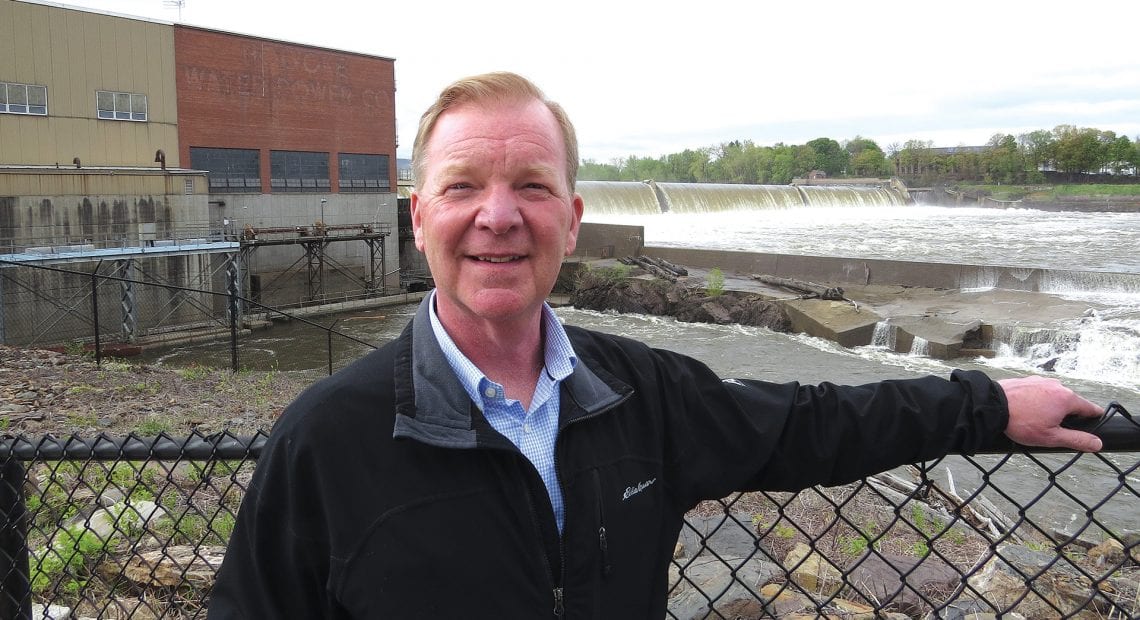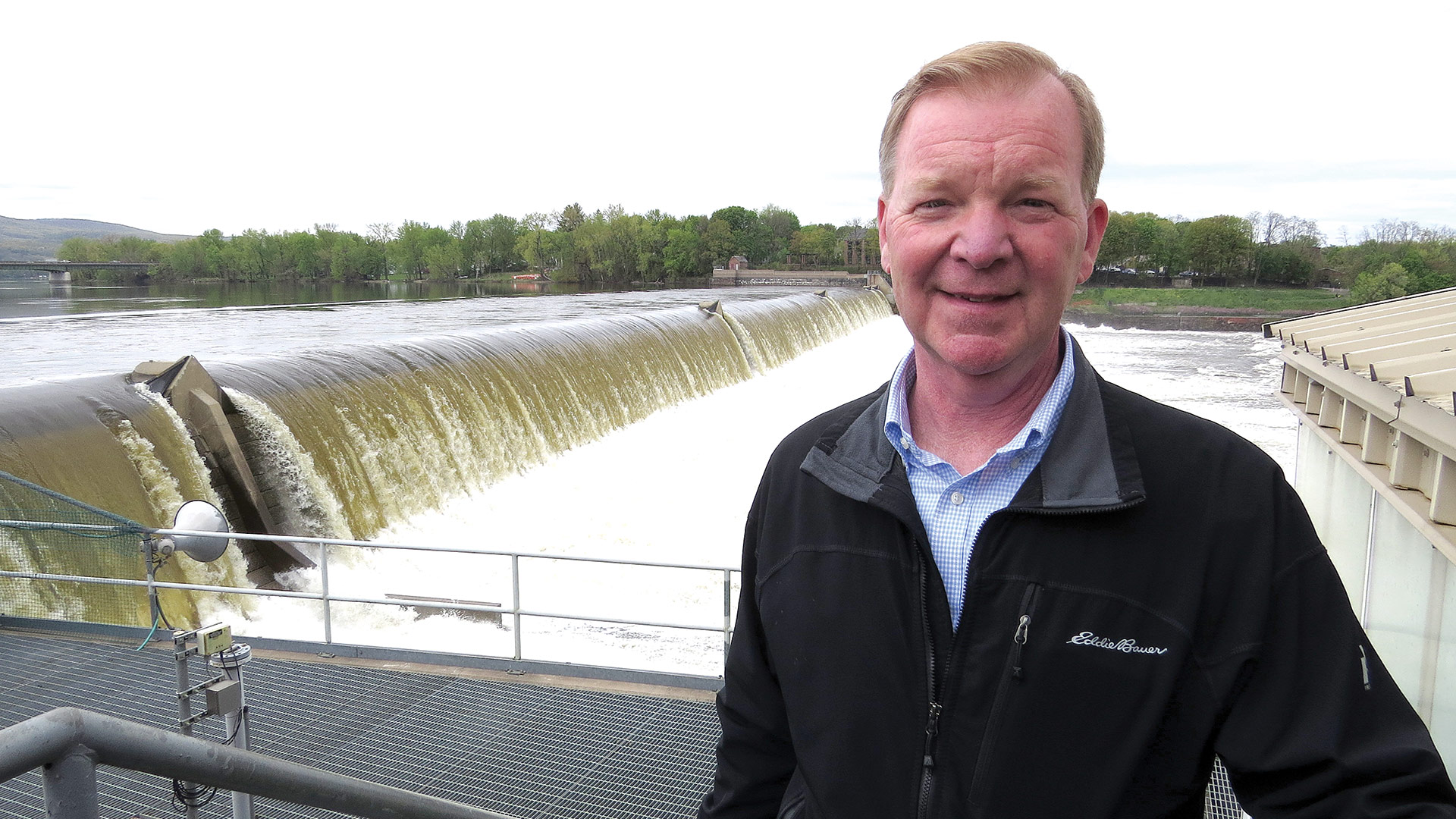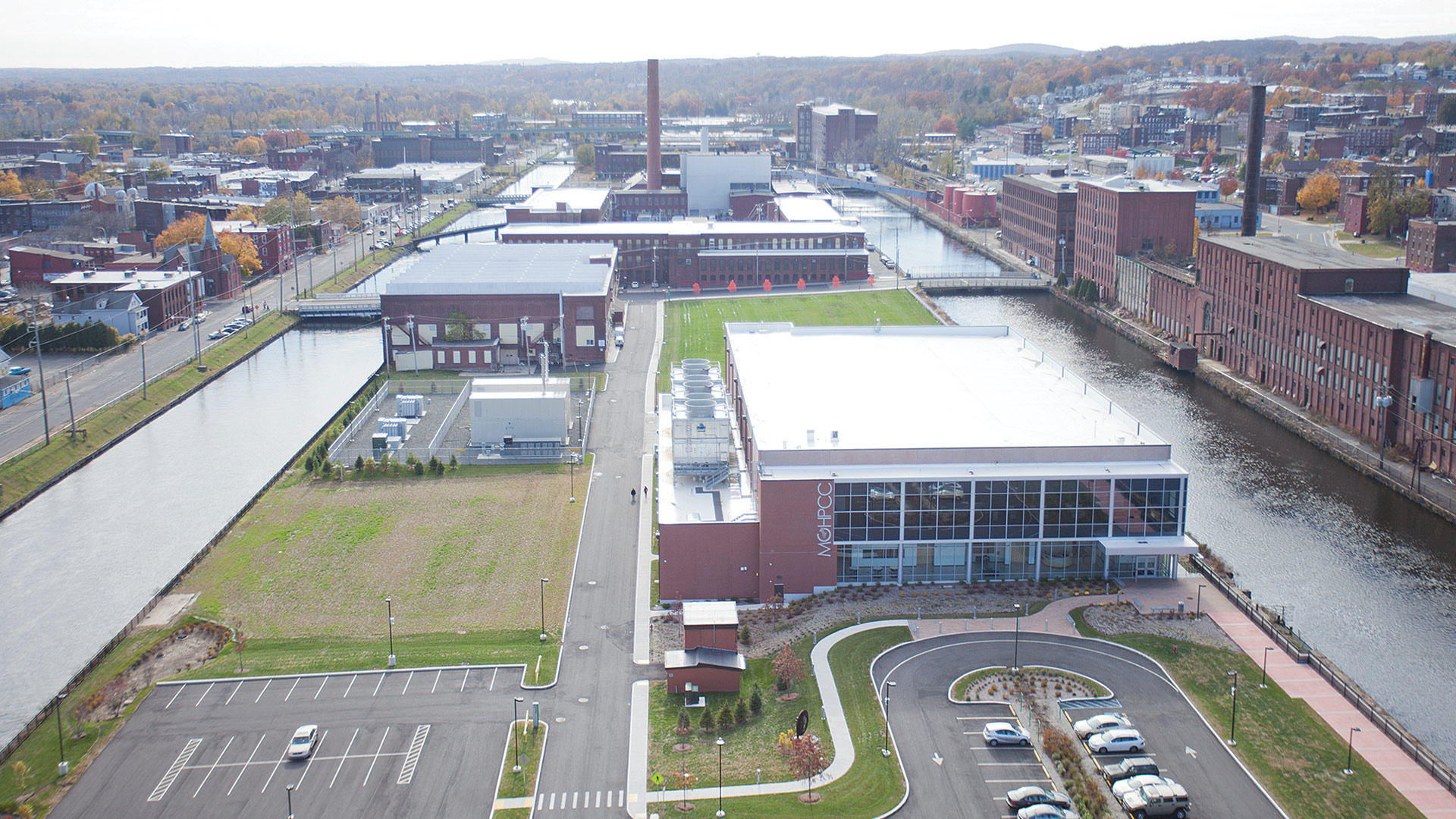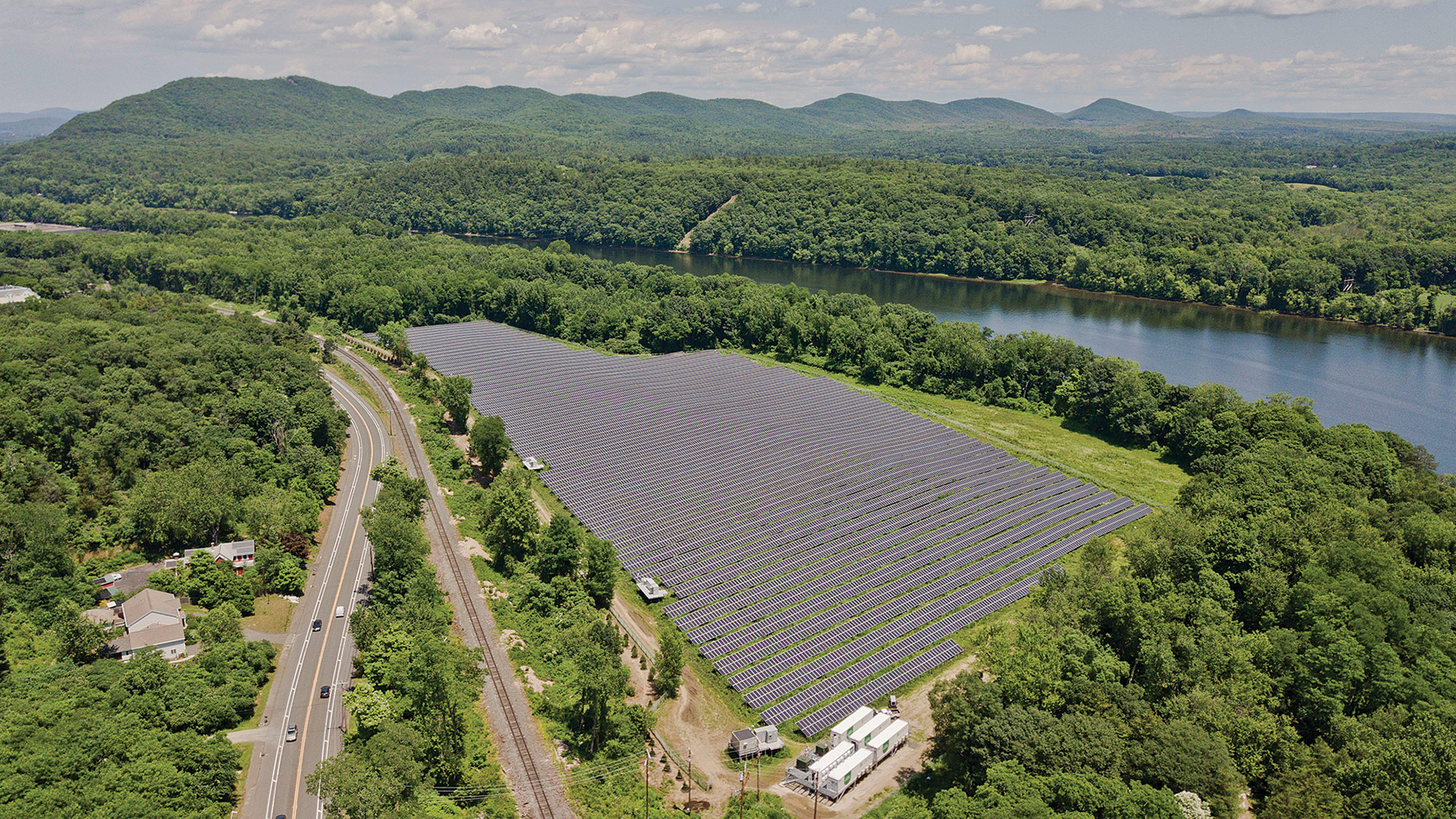
Holyoke’s Utility Takes Leadership Role in Green Energy
Generating Results

Holyoke G&E Manager Jim Lavelle at the hydroelectric facility at the Hadley Falls Dam.
Holyoke Gas & Electric was recently recognized among a handful of utilities nationwide for its leadership in transforming to a carbon-free energy system. That designation, from the Smart Electric Power Alliance, underscores a green-energy mindset at the municipal utility that is not only earth-friendly, but a powerful force when it comes to economic development in the Paper City.
Jim Lavelle acknowledged that Holyoke Gas & Electric (HG&E) has some decided advantages when it comes to clean energy and reducing its carbon footprint.
Take, for example, the hydroelectric facility at the Hadley Falls Dam on the Connecticut River, capable of generating 33 megawatts of electricity, as well as some smaller hydro units located throughout the Holyoke canal system that produce another 15 megawatts — clean-power generation that is beyond the means of many utilities, especially municipal operations.
“We’re extremely fortunate that we have this infrastructure at our disposal — 50 megawatts of hydro in our backyard,” said Lavelle, general manager of HG&E. “It’s a tremendous asset that we try to take full advantage of.”
But HG&E’s commitment to a carbon-free energy system goes well beyond the hydroelectric facility. Indeed, it also includes early adoption of utility-grade solar power (20 megawatts in all), punctuated by the Mount Tom Solar & Energy Storage System. That facility, built near the site of a former fossil-fuel plant, is a large, utility-scale battery and the second such system to be installed in the state, drawing power directly from the solar farm, the largest community solar project in the Commonwealth.
“We’re extremely fortunate that we have this infrastructure at our disposal — 50 megawatts of hydro in our backyard. It’s a tremendous asset that we try to take full advantage of.”
That commitment also includes a diverse power-supply portfolio that includes hydro, solar, nuclear, and wind, as well as efficiency and conservation programs and development of emerging clean-energy technologies, all of which have the utility well-positioned to meet the state’s net-zero target by 2050 (established in the recent clean-energy bill), as well as incremental benchmarks for 2030 (50% below 1990’s emissions levels) and 2040 (75% below).
But long before these mandates and net-zero targets were put in place, HG&E was taking full advantage of its assets, especially those in the clean-energy category, and promoting what it called “cost-competitive clean energy.”

The Massachusetts Green High Performance Computing Center is located in Holyoke, in large part, because of the low-cost, green energy available there.
This track record, coupled with many recent initiatives, has earned HG&E recognition among a handful of utilities nationwide for its leadership in transforming to a carbon-free energy system by the Smart Electric Power Alliance (SEPA) and a spot on the 2021 Utility Transformation Leaderboard. There, it joins just nine other utilities, all of them much larger, including Southern California Edison, Green Mountain Power in Vermont, and Consolidated Edison of New York.
While Lavelle is clearly proud of the award, what it means, and what it says about his utility, he is focused as much on what it — and all of the utility’s efforts toward clean, modern energy — mean for Holyoke. Indeed, the municipal utility and its lower-cost energy have always been selling points and economic-development engines, he said, but they become even more so as the energy becomes cleaner and greener.
“We have a ‘green team’ here that does a lot of our advanced planning on carbon-footprint management, but we also have everyone involved in some way, shape, or form in this effort. Our team is really engaged, and it’s good to see how passionate people are about working toward this objective and how creative they are.”
This was in evidence with the Massachusetts Green High Performance Computing Center, which is based in Holyoke, in large part, because of the availability of vast amounts of clean, lower-cost energy, said Lavelle, adding that these factors also played sizable roles in bringing two huge cannabis-production facilities to the city, with more on the way. And as companies of all kinds look to reduce their carbon footprints, embrace clean energy, and perhaps escape the high lease rates of major urban areas, HG&E and its drive to a carbon-free energy system could bring more businesses to the Paper City.
But while the utility has made great progress in the broad realm of clean energy, it acknowledges there will be stern challenges as it continues down this road.
“With this climate bill … if everyone’s going to convert their gas and oil and propane — their inefficient systems — to cleaner electric systems, that’s going to put a huge demand on our electric capacity,” Lavelle said. “So what we’re forecasting is that we could potentially see a tripling of our electric kilowatt-hour sales by 2050, depending on how we navigate from here to there.
“And even today, we’re seeing that, in certain neighborhoods, all it takes is one resident to put in an electric vehicle, and it taxes the transformer that’s serving that neighborhood,” he went on, adding that upgrading these transformers, built for a different time, will be just one of the many tests awaiting a utility that is committed to being ready for whatever the future brings. And that’s another reason why it’s one of just 10 utilities on SEPA’s short list.

The Mount Tom Solar facility is the largest community solar project in the Commonwealth.
For this issue, BusinessWest takes an in-depth look at Holyoke G&E’s ongoing efforts — and true leadership — with regard to clean-energy transformation, what it means for a city looking to make history of a different kind, and what the road to hitting the state’s benchmarks might look like.
Scaling Up
As he gave BusinessWest a tour of the Hadley Falls Dam facility, which has been powering businesses for more than 150 years, Lavelle talked at length about what else goes on there.
Indeed, this is the site of the Robert E. Barrett Fishway, and the fishlift there helps migrating fish over the dam. In a normal spring, the facility would be visited by dozens of school classes on field trips — and other visitors — who can watch American shad, sea lamprey, sturgeon, and (hopefully) a few Atlantic salmon make their way through the lift and over the dam to resume their journey north. This is not a normal spring, however, and the fishway is closed due to COVID-19.
The work of ferrying fish over the dam continues, however, as does the work of producing electricity at the twin turbines, production that, as noted, is just one of the reasons HG&E finds itself among those utilities identified by SEPA as taking the lead in transforming to a carbon-free energy system.
As it went about completing its report on the state of clean-energy transformation and identifying utilities now on its leaderboard, SEPA listed what it calls the “four dimensions of utility transformation” — clean-energy resources, corporate leadership, modern grid enablement, and allied actions and engagement.
As he talked about his utilities efforts, Lavelle touched on all these elements, starting with those clean-energy resources.
HG&E now has many of them, he said, listing the dam, the Mount Tom Solar and Energy Storage System, and others, which, together, create a diverse, increasingly clean power-supply portfolio.
Beyond this portfolio is a mindset to embrace clean energy, efficiency, conservation, and planning for tomorrow, a mindset that has existed for many years now, long before the state started setting net-zero goals.
“We have a ‘green team’ here that does a lot of our advanced planning on carbon-footprint management, but we also have everyone involved in some way, shape, or form in this effort,” Lavelle noted. “Our team is really engaged, and it’s good to see how passionate people are about working toward this objective and how creative they are.”
The latest example of this passion and creativity is the Mount Tom Energy Storage System. Operated by ENGIE Storage (formerly Green Charge Networks), it is designed to keep electric rates stable by reducing rising demand-based charges for HG&E and its customers by storing energy needed to reduce peak loads — in a clean, environmentally friendly manner.
“Two of the highest-cost elements in our energy ledger are capacity and transmission costs,” said Jonathon Zwirko, HG&E’s project engineer and Energy Resources coordinator. “By timing things properly and discharging the batteries at the right time, we’re able to save on both capacity and transmission costs.”
Through the use of this battery system, which can store 6 megawatt hours of energy at a rate of up to 3 megawatts per hour, the utility can save 2% to 2.5% on its total energy costs annually, a number that will go higher when a second, larger battery facility, this one on Water Street, goes online later this month.

Jim Lavelle at HG&E’s energy-storage system, the second such system to be installed in the state.
The solar facility and energy-storage facility are just a few components of a diverse clean-power portfolio that, as noted, also includes hydro, wind, and nuclear, a portfolio that gives the utility flexibility and the ability to offer competitive rates, Lavelle said.
As noted, this powerful combination has helped bring some businesses to Holyoke that might not otherwise have considered that zip code.
That’s especially true of the cannabis businesses, including large manufacturers, that have, well, put down roots in the city. They’ve been drawn by the hundreds of thousands of square feet of available mill space, said Zwirko, but even more important to them is the large amounts of green, comparatively cheap electricity needed for all elements of the operations, but especially the lights that enable plants to grow.
Green Thumb Industries is currently operating a plant on Appleton Street that consumes roughly 1.5 megawatts of electricity, said Zwirko, noting that Trulieve, which recently moved into the old Conklin Furniture complex just a few hundred yards from the Hadley Falls Dam, will, when operating at peak capacity, consume 4 megawatts. By contrast, Holyoke Medical Center and Holyoke Community College each consume roughly a half-megawatt.
“If we see a tripling of our load, and that power has to come from carbon-free sources, that will be a real challenge. Different camps think offshore wind will fill in a lot of the gaps, but if we’re going to see a tripling of load, every other utility is going to see a tripling of load, so there will be a huge demand.”
So these are huge users of electricity, he went on, adding quickly that HG&E can handle several more of these facilities.
“There are about 10 others that have received licenses and are in the process of construction,” he said, “and we probably have another handful that are knocking on our door, with that 5-megawatt request — each — which we’re prepared to handle.”
Lavelle agreed.
“Part of our strategy with our local grid has been anticipating this growth,” he told BusinessWest, adding that, starting with the computing center, which consumes roughly 4 megawatts, the city has anticipated that it’s blend of clean, inexpensive power would attract more large-scale users. “We weren’t anticipating the cannabis industry at that time, but were targeting and anticipating data-related loads.

The hydroelectric faciliity at the Hadley Falls Dam is just one of HG&E’s many assets when it comes to green energy.
“We’d like to see more people, more jobs, tied to these developments, and while we haven’t seen that on the data side, we’re seeing it on the cannabis side,” he went on, adding that, with improvements made to the system, the city and its utility can accommodate another 15 or 20 megawatts worth of cannabis-related businesses.
Watt’s Happening?
While the utility is well-positioned to handle the needs of the present — and the addition of several more cannabis-related businesses — the future, as noted, is dotted with question marks, especially when it comes to what’s becoming known as ‘electrification’ — of cars and many other things
“If we see a tripling of our load, and that power has to come from carbon-free sources, that will be a real challenge,” Lavelle said. “Different camps think offshore wind will fill in a lot of the gaps, but if we’re going to see a tripling of our load, every other utility is going to see a tripling of load, so there will be a huge demand.”
In the face of these seemingly inevitable surges in demand, utilities, including HG&E, will have to put an even greater emphasis on energy efficiency, conservation, and education to stem the tide, he went on.
“We’re going to have to do those things so we don’t see a tripling of load,” he said. “Can we mitigate, or offset, that growth through energy efficiency and energy conservation and educate people on how to use less energy? We’ll have to. We’ll need to educate people about how to charge their electric vehicles at the right time — at night, right now — at off-peak times.”
Elaborating, he said there will likely be more of what he called “behavioral incentives” that are already being used to change attitudes about clean energy and reduce surges in demand.
Summing up HG&E’s efforts toward transforming its energy system, Lavelle channeled Kermit the Frog by implying strongly that it’s not easy being green. In fact, it’s quite challenging.
But it’s necessary, and for many reasons. The state is demanding it, and, increasingly, customers, both residential and commercial, are demanding it as well.
Well before these demands became loud in nature, HG&E was committed to exploring and implementing strategies to make its power portfolio cleaner and more earth-friendly, knowing they would pay off, not with awards and accolades (although those have come, too) but in cost reductions and opportunities for the city to grow and attract new businesses.
These investments are certainly starting to pay off, and as they do so, HG&E is making a powerful statement, literally and figuratively.
George O’Brien can be reached at [email protected]




